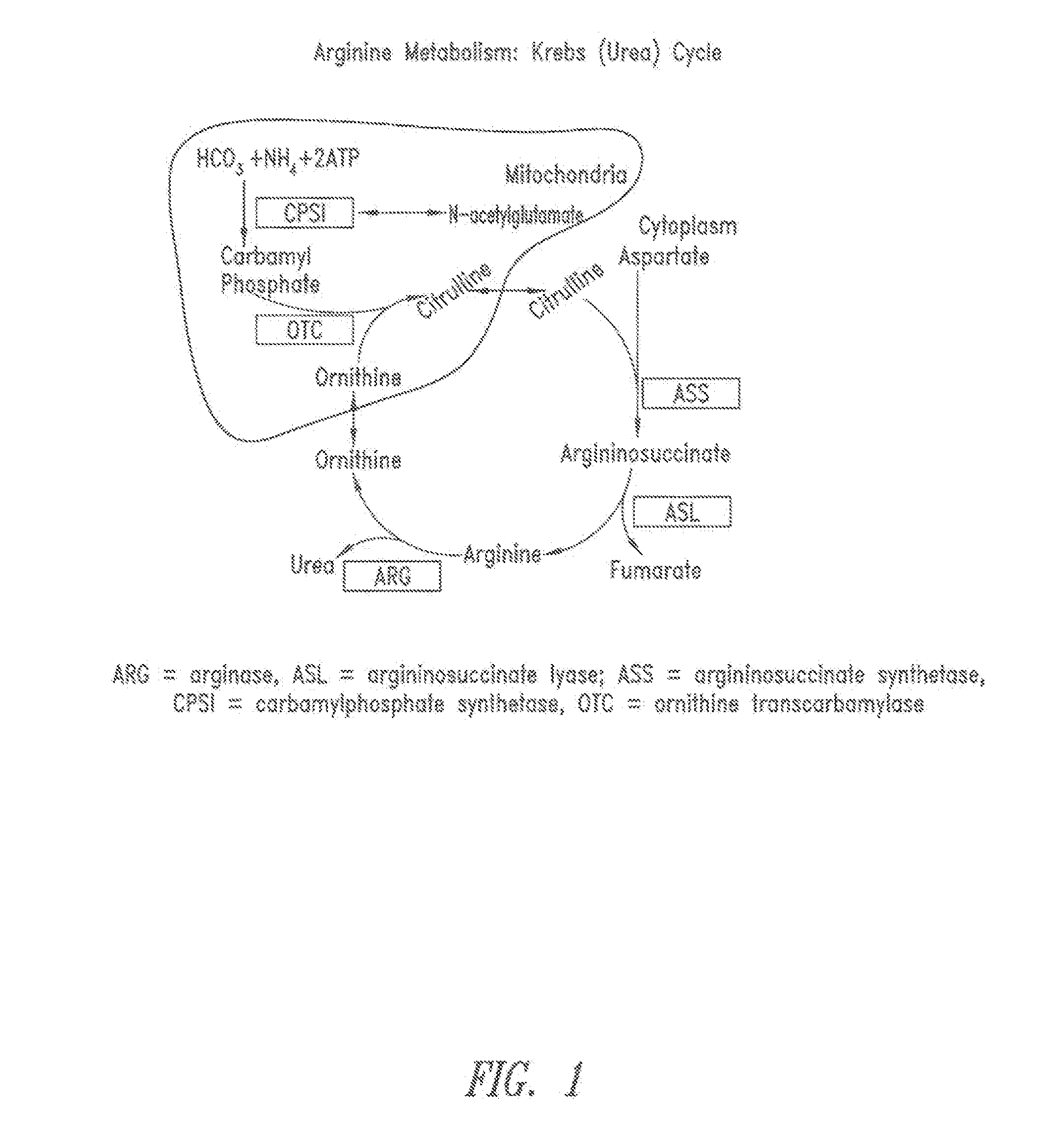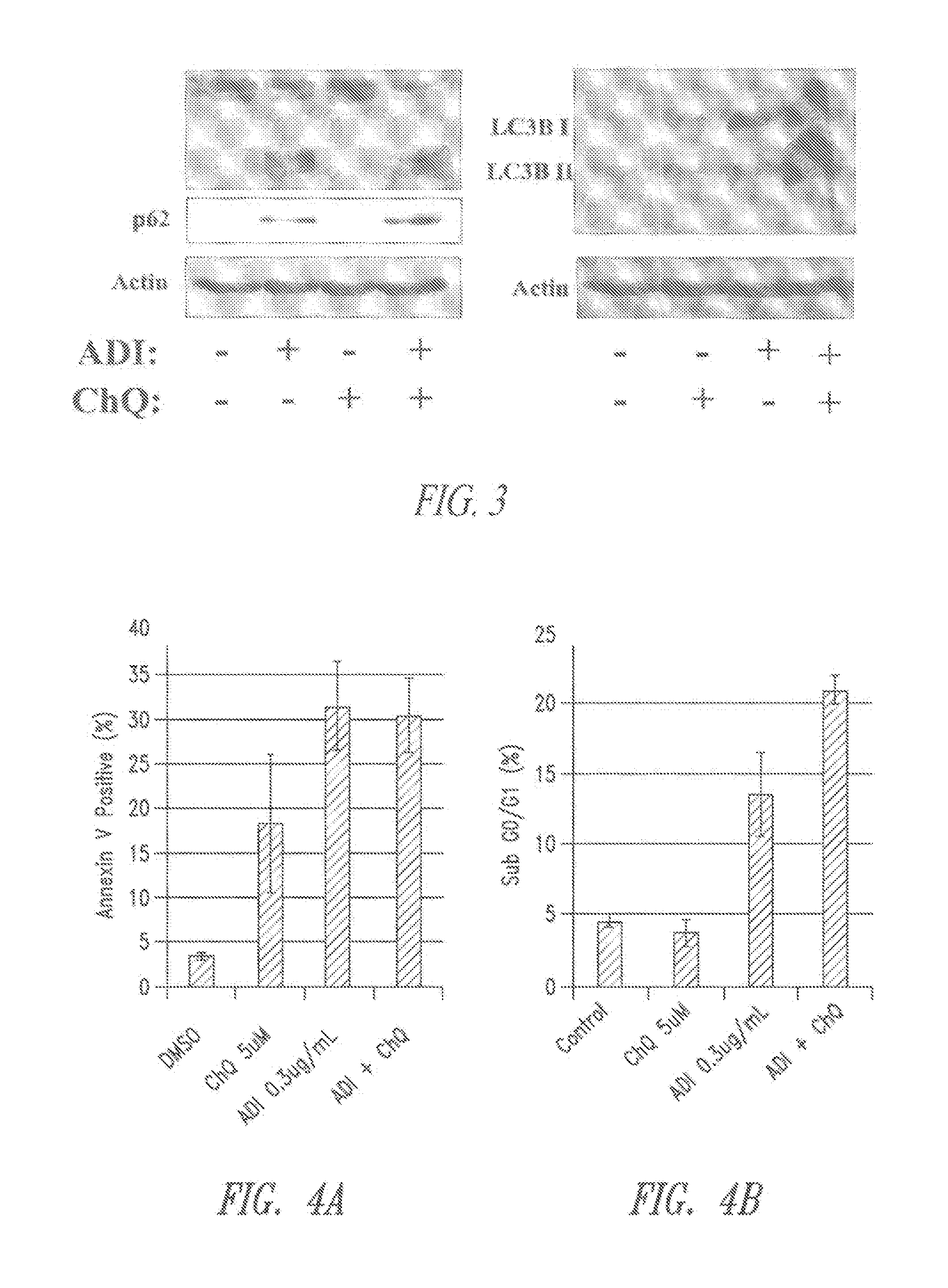Methods of treatment with arginine deiminase
a technology of arginine deiminase and cancer, which is applied in the field of cancer treatment with arginine deiminase, can solve the problems of short serum half-life, prolong the circulating half-life, and reduce the frequency of treatment and the total cost of treatment, so as to inhibit angiogenesis, inhibit no synthesis, and induce apoptosis
- Summary
- Abstract
- Description
- Claims
- Application Information
AI Technical Summary
Benefits of technology
Problems solved by technology
Method used
Image
Examples
example 1
Arginine Deiminase Reduces the Viability of Argininosuccinate Synthase-Deficient Acute Myeloid Leukemia Cells
[0149]Acute myeloid leukemia (AML) is the most common leukemia in adults and the second most common leukemia in children, accounting for a significant share of health care costs with ten thousand cases diagnosed per annum in the US alone. Enzyme-based therapy in the form of asparaginase has revolutionized the treatment of acute lymphoblastic leukemia and there is increasing interest in exploiting analogous tractable metabolic defects in AML. Arginine auxotrophic tumors due to deficiency of the rate-limiting enzyme for arginine production, argininosuccinate synthetase (ASS) are susceptible to arginine-degrading enzymes.
[0150]In this example, it was determined whether ASS negativity would predict for the efficacy of pegylated arginine deiminase (ADI-PEG 20) using AML cell lines and primary AML samples. A lack of ASS protein was identified in three of seven leukemic cell lines (...
example 2
Inhibition of Autophagy Increases Arginine Deiminase-Induced Cell Death of Argininosuccinate Synthase-Deficient Pancreatic Adenocarcinoma Cells
[0152]The role of autophagy and its contribution to cell death is controversial. It was hypothesized that autophagy is protective in the setting of arginine deprivation and that inhibition of autophagy by hydroxychloroquine (ChQ) would increase cell death.
[0153]The human pancreatic cancer cell line MIA-PaCa2 was treated in vitro and in vivo with pegylated arginine deiminase (ADI-PEG) alone or in the presence of ChQ. Cell death was measured by propidium iodide (PI)-FACS to determine sub-G1 DNA content, and apoptosis was evaluated by Annexin V-PI flow cytometry. Cleavage of caspase 3 was evaluated by western blots and ELISA. Autophagy was measured by evaluating the expression levels of LC3 and nucleoporin p62 (p62) by western blots and ELISA.
[0154]In vivo experiments were conducted by generating subcutaneous xenografts in athymic mice followed ...
example 3
Arginine Deiminase Inhibits Argininosuccinate Synthase-Deficient Small Cell Lung Cancer Tumor Growth
[0160]Small cell lung cancer (SCLC) is characterized by a strong initial response to chemotherapy, although the majority of patients go on to relapse (Dowell, Am J med Sci 339(1):68-76, 2010; Rodriguez and Lilenbaum, Curr Oncol Rep 12(5):327-334, 2010). In those patients for whom first-line chemotherapy fails, the chance of response to secondary treatments remains around 10%, and overall survival in these patients is only 3-4 months. Further, current treatment lacks tumor specificity and results in numerous toxicities, and may consequently limit the administration of therapeutics to below the maximally effective dose (Demedts et al, Eur Respir J 35(1):202-215, 2010; Dowell, Am J med Sci 339(1):68-76, 2010; Rodriguez and Lilenbaum, Curr Oncol Rep 12(5):327-334, 2010). This situation highlights the need for the continued development of effective anti-cancer agents with high therapeutic ...
PUM
| Property | Measurement | Unit |
|---|---|---|
| median survival time | aaaaa | aaaaa |
| median survival time | aaaaa | aaaaa |
| median survival time | aaaaa | aaaaa |
Abstract
Description
Claims
Application Information
 Login to View More
Login to View More - R&D
- Intellectual Property
- Life Sciences
- Materials
- Tech Scout
- Unparalleled Data Quality
- Higher Quality Content
- 60% Fewer Hallucinations
Browse by: Latest US Patents, China's latest patents, Technical Efficacy Thesaurus, Application Domain, Technology Topic, Popular Technical Reports.
© 2025 PatSnap. All rights reserved.Legal|Privacy policy|Modern Slavery Act Transparency Statement|Sitemap|About US| Contact US: help@patsnap.com



